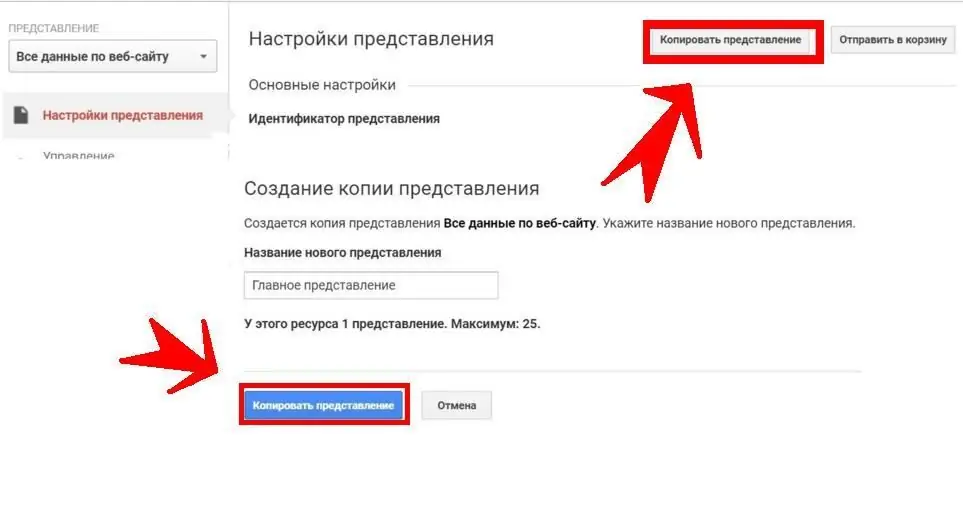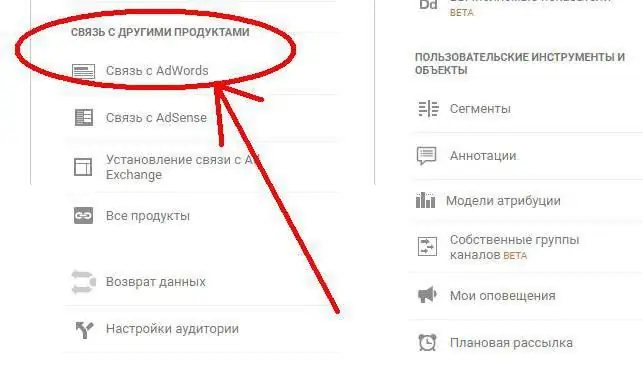Even if you are not an IT specialist, but you have your own website, online store or blog, and you value every visitor, then you just need to navigate modern web analytics services. One of the most powerful analytical services is Google Analytics. At first glance, the structure of Google Analytics may seem complicated, but if you delve into it properly, then dealing with Google analytics is no more difficult than with similar services from other companies.

What parameters can be studied using web analytics services
Let's consider the main site parameters by which you can get results using web analytic services:
- traffic sources - links and ads from which visitors come to your site;
- site audience - morphological features (age, gender, etc.) and the territory where visitors are located;
- website usability - the degree of its convenience and usefulness for the user;
- site conversion - the ratio of thoseusers who visited the site and those who performed some action: purchase or subscription;
- effectiveness of a specific advertising campaign.
Advantages and disadvantages of Google analytics over other services
Specialists highlight the following.
- Google counts are considered the most detailed and informative.
- There is an "E-commerce" tool from Google. If you have an online store, you can view statistics for each user segment and for each product, highlighting the most popular and least popular positions, which will greatly facilitate the selection process for you.
- Scaling websites of any size.
- Data security.
- Integration with AdWords.
- Tracking all advertising campaigns at once and comparing them.
- Google is constantly introducing new technologies to increase the usefulness of analytical readings.
"Google Analytics" according to user reviews is more difficult to use than similar "Yandex Metrics" or LiveInternet. As a rule, a Russian-speaking user needs more time to set up and study Google. But the complexity of using the Google service is a matter of time. Now we will analyze in detail how to create an analytics counter, how to set it up, add it to the site, synchronize it with the site and with the AdWords system. We'll also cover goal setting, view editing, and Google query analytics. Upon closer examination, it will become clear that this web tool is no more difficult to use thanall the rest just have an interface that is not quite familiar to us, which is quite easy to understand.
How to create an analytics counter and how to connect Google Analytics to the site
The algorithm is as follows.
- First you need to register an account in the Google system. To do this, you need to log in and click the "Create an account" button.
- If you already have one, you can skip the previous step and just log in. Google Analytics is displayed in the general Google toolbar.
- Then go to https://google.com/analytics under your account.
- After that, you need to go to the "Administrator" tab (in the admin panel) and create an account there. Multiple websites can be stored in one account.
- Adding your site. In the URL field of the website, enter its full name. It is also important to correctly set the time zone for greater accuracy. If your site works in several time zones, choose the time zone of the place whose audience you are currently interested in more.
- Then you need to click the "Get Tracking ID" button and copy the received code to yourself.
- It remains to confirm the user agreement, and that's it - the counter has been created. Next, add it to the site.
- To add Google Analytics to your resource, you need to paste the copied code into the body of your site immediately after the closing head tag. Copy the code to every page you plan to track.
- Then you need to check the code. To do this, go toyour site and check the registration of this visit in the counts. The visit should show up in real time.
View Settings
After creating and connecting Google Analytics, you need to edit the view. A view is a level of displaying statistics that provides access to data and analytical tools. When we create a counter and an account, the view is configured by default, and it displays absolutely all the data on the counts. But usually certain parameters are analyzed, and all data for one view is not needed. In this case, for convenience, you can use filters in a copy of the original view. The original view, so as not to lose the ability to view all the data, it is better not to delete or apply a filter to it. It is recommended to copy the view first, and only then apply filters.

To copy a view you need:
- go to the admin panel;
- select the desired representation;
- select the View Settings tab and click the Copy View button;
- in the received field, you must enter a new name for the copy, which will differ from the previous one;
- complete the copy by clicking the "Copy View" button.
Then, already in the resulting copy of the view, you need to apply the necessary filters:
- in the "Views" column, select "Filters" and click the "+new filter" button;
- chooseitem "Create a new filter".
You can choose a filter from the standard options offered by the Google Analytics developers, or you can customize it yourself. To choose from ready-made filters, you need to put the switch in the "Built-in" position, if you need to configure the filter yourself, then accordingly click on the "Select" position.
Depending on the purpose, the filters are divided as follows.
- Exclusive - filters that allow you to exclude certain IP addresses from display. For example, the internal traffic of the company, so as not to violate the statistics of visits to the site by employees of your company.
- Inclusive filters are filters that allow you to view the counts for each of the catalogs separately from each other. Or choose just one directory that interests you.
How to track your website's SEO performance
There are two types of scores for evaluating a site's SEO in Google Analytics: keyword scores and search engine scores. In order to see the value of various search engines for your site, you need to open the "Traffic Sources - Search Engines" countdown.
In this countdown, you can see who and when came to the site for a certain period of time, track all the search queries by which search engine users found you. It is also possible to evaluate the quality of traffic - see which of the queries bring the most useful visitors to your site.

Keyword countdownlocated in the "Traffic sources - keywords" tab. In this countdown, you can view general statistics for keywords, as well as separate statistics for paid and unpaid keywords. Paid keys are everything related to AdWords and other contextual advertising that you specify in the settings.

Search query analytics can be used to form a search engine, evaluate the effectiveness of existing seo strategies.
To effectively predict keywords, you can also use the Google Trends and Google Keyword Planner tools. To link to your site, you need to link your analytics account to your Google Webmaster Tools profile. This will allow you to make Google Query Analytics even more effective.
AdWords Ads Analytics
To evaluate advertising campaigns in different search engines, it is recommended to use the built-in analytics services. For example, to view the results for Yandex Direct, it is advisable to use Yandex Metrics, and Google Analytics is the most successful tool for evaluating the effectiveness of existing AdWords advertising campaigns. This is not a strict requirement, but users report discrepancies in the performance of different analytical systems due to different ways of calculating data, so it will be easier to do just that.
In order to see the AdWords counts you need, you must first link your accounts.

To tieGoogle Analytics counter with an AdWords account:
- log into your AdWords account;
- find the "Linked accounts" item in the settings and link the resource you need;
- go to "Google Analytics" in the next tab, open the "Administrator" tab and select the site you need;
- click "Connect" next to the desired tab.
If you did everything right, you will see one blue account. You need to click on it once and add the "All Website Data" view.
Everything, the accounts are linked. Now you can set the goals you need.
How to set goals
You can target any visitor action on the site that you are interested in. This can be either a complete checkout or adding to the cart, as well as leaving your contact details.
Google Analytics will calculate the conversion of your site depending on the goal: the ratio of the total number of visitors to the number of targeted actions. Therefore, determining the right target is very important for building readings.
All target actions can be divided into several types.
- Visit a specific page of the site. A landing page, or landing page, is a narrowly targeted page that serves to attract a potential client to a certain type of action. Tracking from which sources it is visited most often is extremely important for evaluating the effectiveness of advertising campaigns.
- Staying on the site for a certain amount of time. Tracking this parameter will allow you to evaluate the usability of the site andcontent value for the visitor.
- View a certain number of pages on a site. This parameter also allows you to evaluate the convenience of the interface and interest in the posted content. Performing an action: actually making a purchase or registering.
- Directly purchase, subscribe or fill out a website form.
Depending on your tasks, you can select one or more goals and set them up in Google Analytics.
All goals can also be divided into main and auxiliary. The main goals are those that ultimately lead to a sale or registration. Auxiliary - these are goals that are set to obtain intermediate values. You can simply count the number of sales and watch the conversion, but it is precisely for the successful adjustment of your own marketing strategy that you should set the maximum number of intermediate goals out of all possible. That is, the user went to the site, the user viewed the content for a long time, viewed more than 15 similar items, added a product or several products to the cart, opened the registration form, and so on. In this case, you can track at what stage of the sale the majority of customers “fall off”. However, keep in mind that you can add a maximum of 20 goals in one view.
If you use AdWords, then to optimize contextual advertising, you should set up "Smart Goals" of "Google Analytics". The principle of smart goals is as follows: Google analyzes all the actions of visitors on the site and identifies those that most often lead to the achievement of the target indicator and, depending on the incomingdata, optimizes impressions of AdWords advertising campaigns.
Adding Goals to Google Analytics

The following actions must be taken.
- first you need to go to the admin panel and find the "Goals" item;
- you need to add a target by clicking "+ target";
- in the field that appears, enter the name of the page;
- when the target is selected, select the type "Target" and click "Next";
- select "Regular expression" in the drop-down list and enter the page name (its head tag);
- then you need to save the received setting.
All this will allow you to see the conversion directly from your AdWords account.
Creating and using remarketing lists
Remarketing is showing ads to users who have either been on your site or have already made a targeted search query that could lead them to your resource.
Google Analytics can be used to create search remarketing lists. That is, you saw the most conversion request in the “Traffic Sources” countdown. You can set up remarketing on it. Even if the user did not visit the site or left the site for the first time, it is worth adding him to the remarketing list, since this client is warm. It is possible that re-displaying your offer will lead to a sale.

To set up remarketing in analytics, there is an interesting tool "Smart List" - a remarketing audience created using machine learning bythe same principle as smart goals. The neural network analyzes Google search queries and, based on user actions, determines the likelihood of a conversion in the future. In this case, a large amount of data is calculated. If you have more than 10,000 site views per month, the service will generate smart lists based on the behavior of your site visitors. If your traffic turnover is less, then the neural network takes information about user behavior from the websites of companies similar to yours.
Setting up a Smart List in Google Analytics is easy. You need to go to the "Administrator" tab, select the "Remarketing" section and create an audience by selecting the "Smart List" value.
This audience should then be added to AdWords targeting.
All this does not take much time, but in some cases it is very effective in increasing the conversion of the site.
Ways to conveniently use the service
We made sure that "Analytics" from "Google" is not only informative, but also quite an easy-to-use tool. You can even simplify its use in an active life.
Firstly, if you need to monitor traffic and sales non-stop, you should install "Google Analytics" mobile gadget. This will allow you to always be in touch with your own site, and quickly solve problems that arise, even if you are not at your workplace.
Secondly, you can set up sending all the readings to your email.
For this you need:
- open report;
- press the "Open access" button under the name of the reference;
- add recipient addresses in the "To" field;
- select the frequency of sending the countdown, in the "Additional settings" section, mark the desired option in the "Period" field (for example, if you need to send a countdown every week for two months, then select the week in the "Frequency" field, and in the "Period" write two months);
- send by clicking on the appropriate button.
Depending on the frequency and period settings, the countdown will automatically come to you according to the schedule you set.






